Suriname Sphingini:
Agrius, Amphimoea, Neococytius,
Cocytius, Amphonyx, Morcocytius, Pseudococytius
 |
 |
I have arranged the images in accordance with my perception of wing characters: predominent markings, shape, colour, size.
Females often have a wing shape or pattern that differs from the males. I hope some day to also have a thumbnail checklist for the females.
Agrius, Amphimoea, Neococytius
|
Cocytius, Amphonyx, Morcocytius, Pseudococytius |
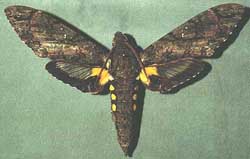 Cocytius antaeus Fw upperside semitransparent posterior to vein CuA1; black dash here consequently more or less obliterated; dash posterior to vein M3 heavier, buffish white subbasal line separated into costal, more distal disco-cellular, and posterior part, differing from Cocytius duponchel in that posterior part is more distal, at right-angles to cubital vein and more distal than costal part; the reverse is true in Cocytius duponchel; postdiscal line more curved than in Cocytius duponchel. Both wings undersides often with conspicuous ochre-yellow wash. Hindwing upperside with transparent spaces long, that posterior to vein M1 obviously longer than the brown wing border is broad; these spaces incised distally as the border is dentate between veins; a semitransparent patch that posterior to vein CuA2 anteriorly. |
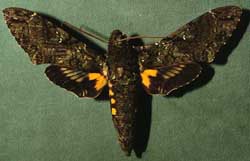 Amphonyx duponchel Two thin dark streaks from upper thorax to mid thorax where they expand into teardrops. Forewing upperside with black discal dashes between veins M3 and CuA2 not prominent; discal spot transverse, kidney-shaped, dirty white. Hindwing upperside with translucent patch posterior to vein M1 shorter than the black marginal band is broad at vein M1 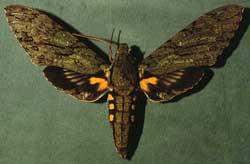 Amphonyx lucifer Thorax: black markings prominent against greyish green. Abdomen: mesial line usually prominent, sometimes faint or widely interrupted. Ground colour varies from walnut shell, yellowish-brown to greenish-grey. Two narrow, distinct dark streaks posterior to veins M3 and CuA1. |
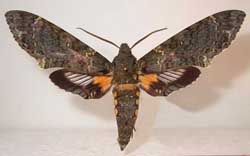 Morcocytius mortuorum Dull orange band across upper abdomen at junction with thorax. Three small yellow-orange dots between each abdominal segment, Note strong presence of white scales in antemedial line. Forewings lack streaks or bars. 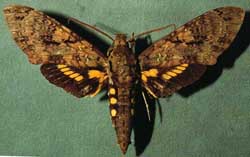 Pseudococytius beelzebuth More orangey-brown shading on forewing than in other species in this group. Strong presence of black diagonal line from costa to cell. Line, interrupted by cell, continues as thicker, shorter black bar, parallel to inner margin. Black, much thinner streak often interrupted above bar. |
Sphingini: Manduca
You are here: Sphingini: Agrius, Amphimoea, Cocytius, Amphonyx, Morcocytius, Pseudococytius
Smerinthini: Adhemarius and Protambulyx
Dilophonotini: Aleuron, Enyo, Pachygonidia and Unzela
Dilophonotini: Aellopos, Eupyrrhoglossum, Nyceryx and Perigonia
Dilophonotini: Callionima, Erinnyis, Hemeroplanes, Isognathus, Madoryx, Oryba, Pachylia, Pachylioides, Phryxus
and Pseudosphinx
Philampelini: Eumorpha
Macroglossini: Hyles and Xylophanes
Go to Main Sphingidae Index
Go to Indices of Nations
Go to South American Index
Go to Central American Index
This page is brought to you by Bill Oehlke and the WLSS. Pages are on space rented from Bizland. If you would like to become a "Patron of the Sphingidae Site", contact Bill.
Please send sightings/images to Bill. I will do my best to respond to requests for identification help.
 Show appreciation for this site by clicking on flashing butterfly to the left. The link will take you to a page with links to many insect sites. |